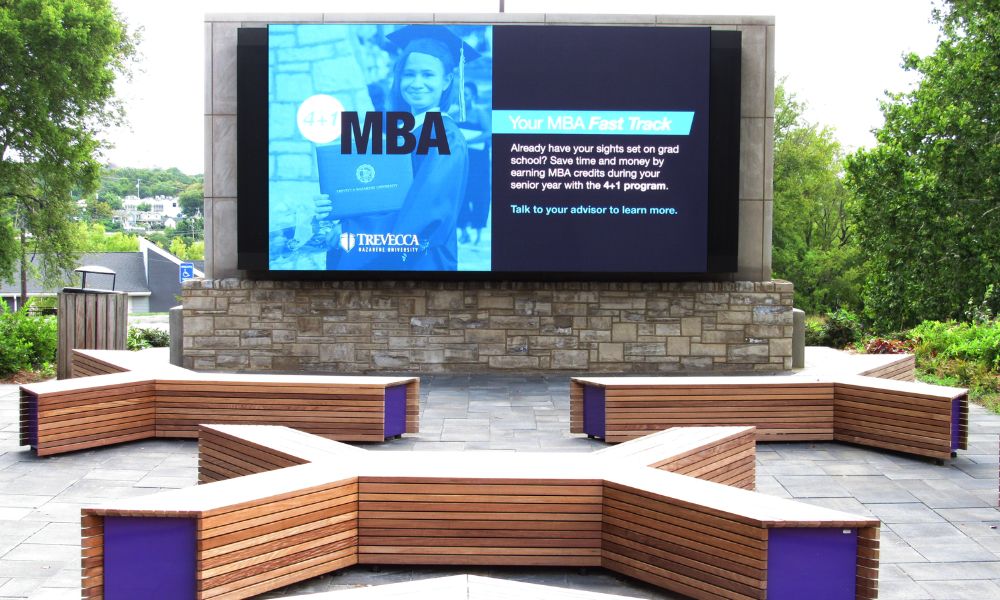Inside the Tech: How Do Outdoor LED Signs Work?

Outdoor LED displays are an impressive feat of technology. Brilliant color and brightness create visually stunning images that turn heads and generate attention for your business. Outdoor LED signs can display trillions of colors in a radiant portrayal of text, images, and animation. When you need outdoor signage that stands out among the rest, it’s clear that LED signs are the solution.
How do outdoor LED signs work, though? A lot of design and engineering goes into ensuring you have the most effective signage solution possible. Moreover, outdoor LED signs use advanced technology to create a durable and lasting display that can continue to shine bright in different seasons, weather patterns, and times of day.
Take a peek inside the technology behind outdoor LED signs with this guide to the science, equipment, and other innovations that create brilliant, effective outdoor LED signage.
What Are LEDs?
To understand any kind of LED sign, you must first know your way around LEDs and how they operate. LED stands for light-emitting diode. These diodes come in three colors: red, blue, and green.
LEDs are a far more efficient lighting solution than incandescent bulbs. Each LED operates through complex electronic circuits and software. The LED lights contain a microchip. When electricity hits that microchip, it illuminates the diodes and creates visible light. Meanwhile, a heat sink absorbs any heat produced alongside that light. LEDs don’t burn out the way traditional electric light sources do, which means they can shine brighter and last longer than competing solutions.
While individual light-emitting diodes are tiny units, they form the foundation of all LED signs, thus making them an integral part of how outdoor LED signs work. By working together, multiple tiny LED lights can create a bright, consistent display of trillions of colors.
Creating a Pixel
Individual diodes or diode clusters form pixels, which go on to create the colors and images of the LED display. There are two main types of LED pixels: surface-mounted diode (SMD) pixels and discrete pixels. Both types of pixels offer outstanding variety in size, configurations, and brightness levels, making them both versatile LED solutions.
SMD pixels consist of a single diode that contains one red, one blue, and one green LED. Because these LEDs are within a single diode, they can sit closer together, creating a tighter pixel pitch and a higher resolution.
Discrete pixels consist of clusters of individual LED diodes. One red, one blue, and one green LED pixel work together to create a single discrete pixel.
LED pixels work when the individual color diodes change in brightness. The varying intensities of the diodes create a full range of colors. Holding specific intensity levels across the LED sign creates a stationary image, while turning diodes on or off at different speeds can create motion and animation.
Traditionally, SMD pixels were the popular choice for indoor LED signs. The tighter pixel pitch and clearer resolution make SMD pictures ideal for signs with shorter viewing distances. Additionally, older LED technology meant SMD pictures weren’t as bright as discrete pixels. However, modern LED technology creates a dazzling display with both SMD and discrete pixel modules. Both options offer full-color brightness for any digital sign.
The Importance of Pixel Pitch
Pixels are the building blocks of LED signs. They work across the entire screen to create a cohesive image. The number of pixels in a display and the distance between individual pixels determine the screen’s resolution.
Low pixel density—fewer pixels with more distance between them—makes it easy to see the individual pixels when you’re up close. This creates a low-resolution image. High pixel density, on the other hand, means there are more pixels with smaller spaces between them. This tighter pixel pitch makes it harder for viewers to see the individual pixels making up the image, thus creating a higher-resolution display.
LED Tiles
Tiles are another way to create and measure pixel density in an LED display. LED tiles consist of groups of pixels. Tiles connect these individual pixels in a square formation. More pixels on a tile means greater pixel density and a higher image resolution. In an LED sign, tiles connect in horizontal rows and vertical columns to create a seamless grid across the entire screen. Calibration ensures uniform color and brightness across every tile to create a clear and brilliant image.
Navigating Outdoor Viewing Distance
The right pixel pitch allows your LED display to be clear, legible, and captivating at the right viewing distance. In outdoor displays, that viewing distance is generally larger, so pixel pitch can be larger to display bigger text and images at a greater distance.
No two signs are alike, though. The right pixel pitch for one display won’t be as successful in another. Outdoor LED sign manufacturers must factor in viewing distance, location, size, and other details to create the most useful display possible. The configuration of LED tiles and a range of pixel pitch options allow us to create a sign that displays content precisely how you need it, making your message as effective as possible for viewers in that specific location.
Compensating for Outdoor Lighting and Environments
Resolution and viewing distance aren’t the only factors to consider when building and implementing outdoor LED signs. The outdoor environment also presents challenges in the form of different lighting and visibility conditions.
An indoor display looks the same all day long, but an outdoor display will look different at night, in the light, on a cloudy day, in the rain, during a foggy day, and throughout countless other weather conditions. A sign that is too bright at night might appear dull in direct sunlight.
Sign manufacturers avoid these issues through innovations such as manual or automatic dimming options. With more control over the display brightness, sign owners can ensure their displays are efficient, effective, and comfortable to look at in any condition.
At Optec Displays, we design our outdoor digital signs with only the highest quality materials and components. From the individual diodes to the durable cabinets, every piece offers efficiency, durability, and performance. Our premium LED displays can make all the difference for you and your business. Contact Optec today to learn more about our outdoor LED sign options and get started with your digital signage solution.

